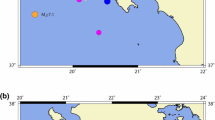Abstract
Scientists mapped the seismic time series into networks by considering the geographical location of events as nodes and establishing links between the nodes with different rules. Applying the successively defined models to construct the networks of seismic data, a variety of features of earthquake networks are detected (scale-free and small-world structures). Network construction models had changed in detail to optimize the performance of the verification of the minimum geographical size defined for the node. In all the studies, people try to use large data sets like years of data to ensure their results are good enough. In this work, by proposing the temporal network construction and employing the small-worldness property for data from Iran and California, we could achieve the minimum time scale needed for the best results. We verified the importance of this scale by analyzing two significant centrality measures (degree centrality and PageRank) introduced in the concept of earthquake network.






Similar content being viewed by others
References
Abe S, Pastén D, Muñoz V, Suzuki N (2011) Universalities of earthquake-network characteristics. Chinese Sci Bull 56(34):3697–3701
Abe S, Pastén D, Suzuki N (2011) Finite data-size scaling of clustering in earthquake networks. Physica A 390(7):1343–1349
Abe S, Suzuki N (2004) Scale-free network of earthquakes. Europhys Lett 65(4):581
Abe S, Suzuki N (2004) Small-world structure of earthquake network. Physica A 337(1–2):357–362
Abe S, Suzuki N (2005) Scale-invariant statistics of period in directed earthquake network. Eur Phys J B 44(1):115–117
Abe S, Suzuki N (2006) Complex-network description of seismicity. Nonlinear Proc Geophys 13(2):145–150
Baiesi M, Paczuski M (2004) Scale-free networks of earthquakes and aftershocks. Phys Rev E 69(6):066106
Bak P, Christensen K, Danon L, Scanlon T (2002) Unified scaling law for earthquakes. Phys Rev Lett 88(17):178501
Belardinelli M, Bizzarri A, Cocco M (2003) Earthquake triggering by static and dynamic stress changes. J Geophys Res 108(B3)
Brin S, Page L (1998) The anatomy of a large-scale hypertextual web search engine. Comput Netw ISDN 30(1–7):107–117
Chorozoglou D, Papadimitriou E, Kugiumtzis D (2019) Investigating small-world and scale-free structure of earthquake networks in greece. Chaos, Solitons & Fractals 122:143–152
Darooneh AH, Lotfi N (2014) Active and passive faults detection by using the pagerank algorithm. Europhys Lett 107(4):49001
Donges JF, Donner RV, Kurths J (2013) Testing time series irreversibility using complex network methods. Europhys Lett 102(1):10004
Freed AM (2005) Earthquake triggering by static, dynamic, and postseismic stress transfer. Annu Rev Earth Planet Sci 33:335–367
Gutenberg B (2013) Seismicity of the earth and associated phenomena, Read Books Ltd
Gutenberg B, Richter CF (1944) Frequency of earthquakes in california. Bull Seismol Soc Am 34(4):185–188
Humphries MD, Gurney K (2008) Network ‘small-world-ness’: a quantitative method for determining canonical network equivalence. PLoS ONE 3(4):e0002051
Kanamori H, Brodsky EE (2001) The physics of earthquakes. Phys Today 54(6):34–40
King GC, Stein RS, Lin J (1994) Static stress changes and the triggering of earthquakes. Bull Seismol Soc Am 84(3):935–953
Lacasa L, Luque B, Ballesteros F, Luque J, Nuno JC (2008) From time series to complex networks: the visibility graph. Proc Natl Acad Sci 105(13):4972–4975
Lacasa L, Luque B, Luque J, Nuno JC (2009) The visibility graph: a new method for estimating the hurst exponent of fractional brownian motion. Europhys Lett 86(3):30001
Lacasa L, Toral R (2010) Description of stochastic and chaotic series using visibility graphs. Phys Rev E 82(3):036120
Lotfi N, Darooneh A (2012) The earthquakes network: the role of cell size. Eur Phys J B 85(1):1–4
Lotfi N, Darooneh AH (2013) Nonextensivity measure for earthquake networks. Physica A 392(14):3061–3065
Lotfi N, Darooneh AH, Rodrigues FA (2018) Centrality in earthquake multiplex networks. Chaos 28(6):063113
Omori F (1894) On the aftershocks of earthquakes. J Coll Sci 7:111–120
Rezaei S, Darooneh AH, Lotfi N, Asaadi N (2017) The earthquakes network: retrieving the empirical seismological laws. Physica A 471:80–87
Rezaei S, Moghaddasi H, Darooneh AH (2019) Pagerank: an alarming index of probable earthquake occurrence. Chaos 29(6):063114
Acknowledgements
N. Lotfi is thankful to the FAPESP (grant with number 2020/08359-1) for the support given to this research.
Author information
Authors and Affiliations
Corresponding author
Ethics declarations
Conflict of Interest
The authors declare that they have no known competing financial interests or personal relationships that could have appeared to influence the work reported in this paper.
Additional information
Edited by Dr. Rodolfo Console (ASSOCIATE EDITOR) / Prof. Ramón Zúñiga (CO-EDITOR-IN-CHIEF).
Rights and permissions
Springer Nature or its licensor (e.g. a society or other partner) holds exclusive rights to this article under a publishing agreement with the author(s) or other rightsholder(s); author self-archiving of the accepted manuscript version of this article is solely governed by the terms of such publishing agreement and applicable law.
About this article
Cite this article
Lotfi, N. The earthquake network: the best time scale for network construction. Acta Geophys. 71, 2565–2571 (2023). https://doi.org/10.1007/s11600-023-01134-0
Received:
Accepted:
Published:
Issue Date:
DOI: https://doi.org/10.1007/s11600-023-01134-0




